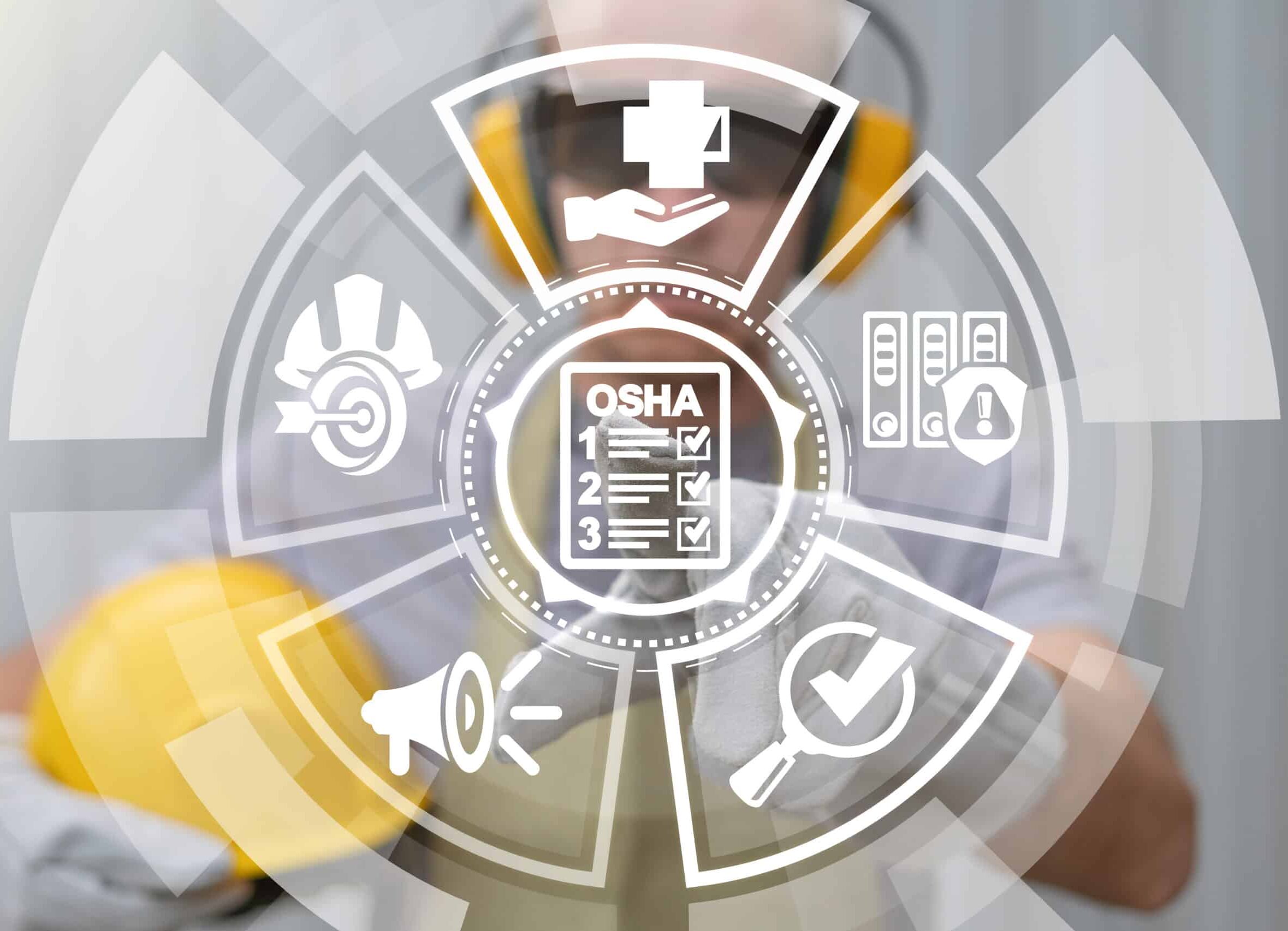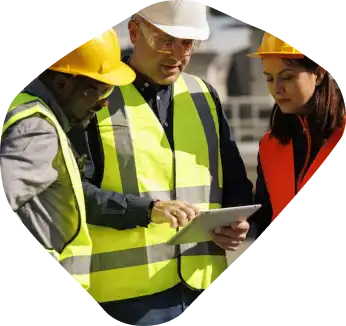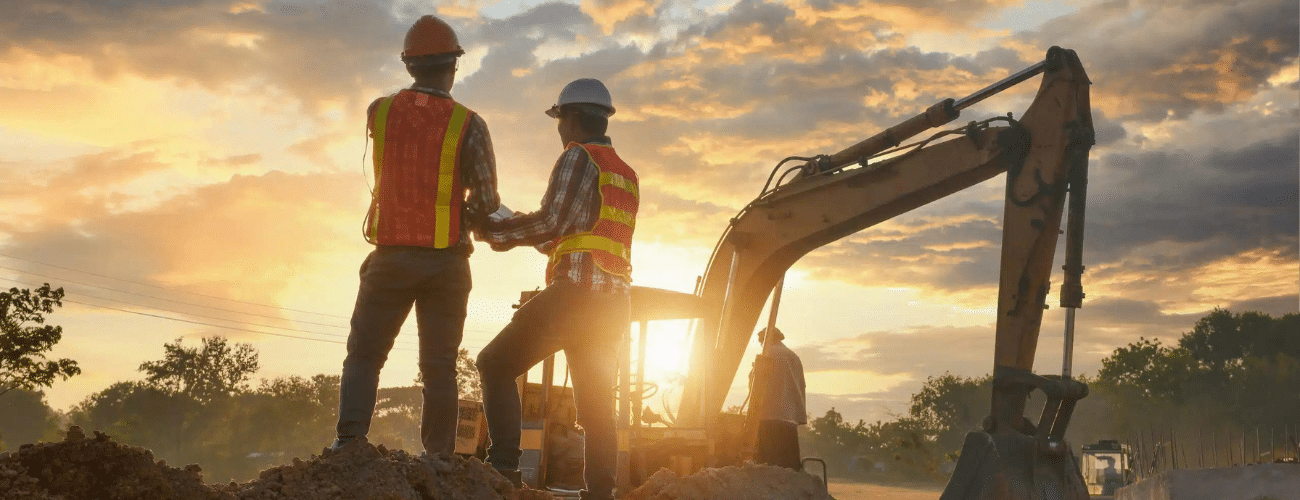March 5, 2024 7 min read

11 Construction Safety Topics Employee Training Must Cover
Industry:
Solution:

Safety training saves lives. In the construction industry, this training is vitally important. Experiencing the highest fatalities of any industry, firms must take construction training seriously. In this blog, we’ll review 11 of the most important construction safety topics to cover in employee training. These topics align with OSHA regulations and can help you prevent the most common causes of injuries and save lives.
What Are the Top 4 Construction Hazards?
Before we dive into the topics you should cover in your safety training, it’s important to understand the top hazards in construction.
The top causes of injuries and fatalities in construction are what OSHA calls the “Fatal Four”:
- Falls
- Struck-By
- Caught-In/Between
- Electrocutions
Being more aware of the safety issues on a construction site can help prevent these incidents.
What Are the Biggest Safety Issues on a Construction Site?
The Fatal Four (also called the Focus Four) are a good indicator of what the biggest areas for safety improvement are in construction:
- Scaffolding. When not installed or used correctly, scaffolding can be dangerous and lead to falls.
- Lack of fall protection. Construction crews who don’t use proper personal protective equipment (PPE) or use guardrails and safety nets are at greater risk of falling.
- Inadequate equipment. All safety equipment and tools must be properly maintained to keep employees safe from harm.
- Lack of communication. Failing to communicate effectively and report hazards can lead to numerous safety hazards.
- Ineffective training. Training can help prevent all kinds of safety incidents. But if training is cut short, out of date, or not enforced, this can create an unsafe work environment.

What Construction Safety Topics Are Required By OSHA?
To remain compliant with OSHA, it’s important to ensure crews go through OSHA 10-hour and 30-hour construction training. These programs cover the safety topics that OSHA requires to ensure your crews remain safe. This includes topics like:
- Electrical Hazards
- Fall Protection
- Materials Handling
- Cranes and Rigging
- Motorized Mobile Platforms
- Excavations
- Forklift Hazards
There are additional topics that OSHA requires. To learn more, check out our comprehensive guide to OSHA 10 construction.
OSHA Reporting & Recordkeeping Guide
Explore how to comply with OSHA’s Requirements for reporting and recording work-related injuries and illnesses
View Guide
11 Construction Safety Topics to Cover in Training
So, based on OSHA requirements and top environmental hazards, what construction safety topics are vital to a successful training program? We have 11 that absolutely make the list, but this isn’t necessarily exhaustive. There are numerous other topics that might matter to your specific operation.
If you want help getting your construction training program started, consider using our learning path for nine essential construction roles ⬇️
A Learning Path Template for 9 Essential Construction Roles
Optimize your employees’ learning journey and foster career development within your organization with our powerful learning path tool.
Download Template
1. Fall Prevention and Protection
The Topic: Fall prevention and protection encompass strategies and equipment designed to minimize the risk of falling from elevated surfaces, such as ladders, scaffolds, or roofs.
Why it Matters: Falls are a leading cause of construction-related injuries and fatalities. Proper fall prevention measures significantly reduce the likelihood of accidents, ensuring worker safety.
Training Required: Conduct comprehensive training on the proper use of personal protective equipment (PPE), including harnesses and lanyards. Emphasize the importance of regular equipment inspections and adherence to OSHA regulations.
2. Electrical Safety
The Topic: Electrical safety involves understanding and mitigating risks associated with electricity, including potential shock hazards and fire risks.
Why it Matters: Electrical accidents can result in severe injuries or fatalities. Proper training ensures workers understand the dangers of electricity and adopt safe work practices.
Training Required: Cover the basics of electrical hazards, safety measures when working with power tools, and procedures for working near power lines. Include hands-on exercises and demonstrations to reinforce learning.
3. Materials Handling
The Topic: Materials handling focuses on safe techniques for lifting, carrying, and transporting construction materials to prevent injuries and property damage.
Why it Matters: Improper materials handling can lead to musculoskeletal injuries, contributing to long-term health issues for workers. Training promotes safe practices and reduces the risk of accidents.
Training Required: Incorporate practical demonstrations of proper lifting techniques, use of mechanical aids, and guidelines for transporting materials safely. Encourage regular breaks to prevent overexertion.
4. Scaffolding Safety
The Topic: The proper assembly, use, and inspection of scaffolds to prevent falls and ensure a secure working platform.
Why it Matters: Scaffold-related accidents are often linked to improper assembly or usage. Effective training safeguards workers against falls and structural failures.
Training Required: Provide detailed instructions on scaffold assembly, use, and inspection. Include hands-on training sessions and assessments to ensure workers can identify and rectify potential issues.
5. Struck-By Hazards
The Topic: Struck-by hazards training educates workers on the risks associated with moving vehicles, equipment, and falling objects on construction sites.
Why it Matters: Struck-by incidents are common causes of construction injuries. Training raises awareness and instills preventive measures to reduce the likelihood of accidents.
Training Required: Use real-life scenarios and case studies to highlight potential struck-by hazards. Emphasize the importance of maintaining a safe distance, wearing high-visibility clothing, and using designated walkways.
6. Caught-In/Between Hazards
The Topic: Caught-in/between training focuses on preventing accidents related to equipment entanglement, trench collapses, or being caught between machinery and structures.
Why it Matters: These accidents can lead to severe injuries or fatalities. Training instills a proactive approach to avoiding such situations.
Training Required: Provide detailed guidance on equipment operation, trenching, and shoring techniques. Conduct practical demonstrations and reinforce the importance of maintaining situational awareness.
7. Cranes and Rigging Safety
The Topic: The proper operation of cranes, safe rigging practices, and adherence to load capacity guidelines.
Why it Matters: Accidents involving cranes can result in catastrophic consequences. Training ensures workers understand safe operating procedures and mitigate risks.
Training Required: Combine theoretical knowledge with practical exercises on crane operation and rigging techniques. Stress the significance of pre-operation inspections and proper communication during lifting operations.
8. Motorized Mobile Platforms
The Topic: Motorized mobile platforms safety focuses on the safe operation of equipment like aerial lifts and scissor lifts, including fall protection measures.
Why it Matters: Unsafe operation of motorized platforms can lead to falls and accidents. Training imparts the necessary skills for safe usage and maintenance.
Training Required: Review proper equipment setup, operation, and emergency procedures. Emphasize the importance of personal fall protection equipment.
9. Excavation Safety
The Topic: Excavation safety training provides guidelines for safe excavation practices, trenching, and shoring techniques to prevent collapses and cave-ins.
Why it Matters: Trenching accidents can be deadly. Training ensures workers can identify and address potential hazards during excavation activities.
Training Required: Combine online instruction with practical demonstrations of trenching and shoring methods. Highlight the importance of soil analysis and regular inspections.
10. Forklift Hazards
The Topic: Forklift hazards training focuses on the safe operation of forklifts, including load handling, pedestrian safety, and proper equipment maintenance.
Why it Matters: Unsafe forklift operation poses risks to both operators and those working in proximity. Training ensures proper usage and minimizes the potential for accidents.
Training Required: Cover forklift safety in online training first so employees have a good baseline of knowledge. Then reinforce that training with hands-on training sessions with actual forklifts, covering key operating principles and safety protocols.
11. Emergency Response and Communication
The Topic: The procedures to follow during emergencies and the importance of effective communication.
Why it Matters: In emergencies, a lack of preparedness and communication can exacerbate the situation. Training ensures workers can respond calmly and communicate effectively.
Training Required: Teach the essentials with eLearning, and then simulate emergency scenarios and conduct drills to practice response procedures. Include communication protocols and emphasize the role of each team member in emergency situations.

Choosing a Best-in-Class Construction Safety Training Provider
With a profound understanding of the AEC industry, Vector Solutions’ eLearning courses ensure OSHA compliance, covering essential construction safety topics. Our award-winning HSE Course Library and safety case studies ensure your employees learn, comprehend, and retain potentially life-saving information.
What sets us apart is our commitment to engagement—our content is 3D and scenario-based, making learning memorable. You benefit from a comprehensive library, EHS management tools, a robust Learning Management System, and continuous support.
Elevate your team’s safety proficiency today! Request a demo to learn more.








